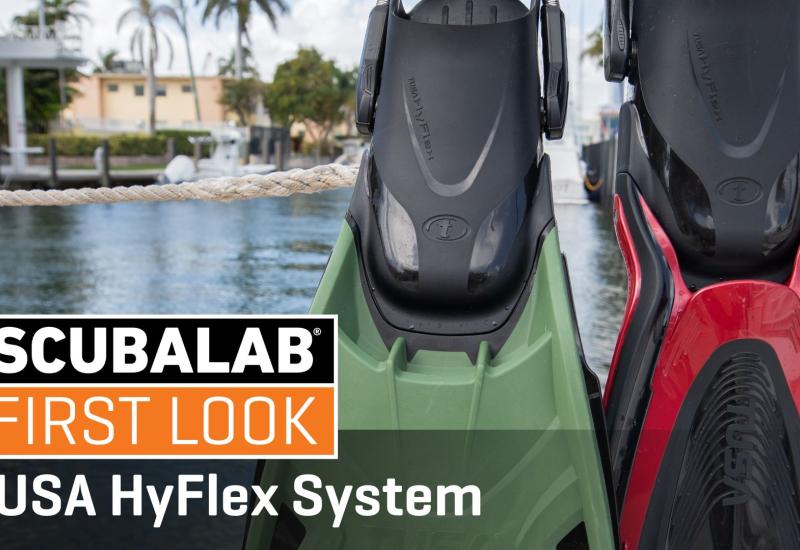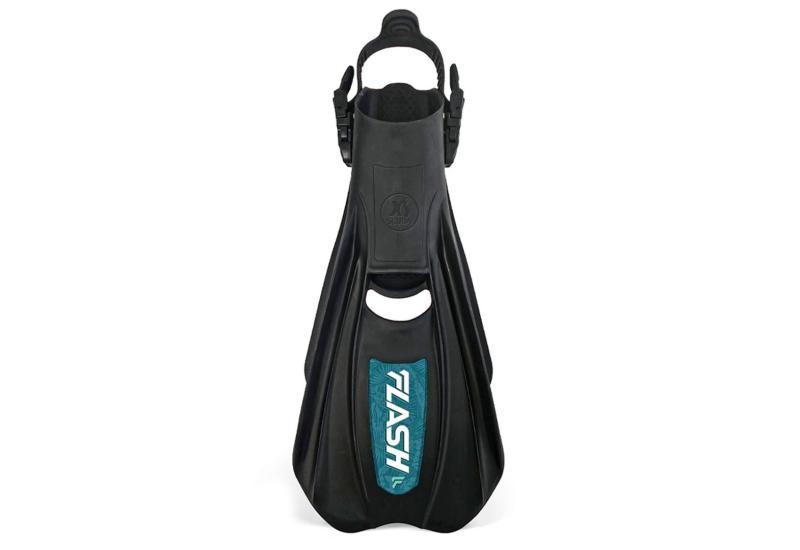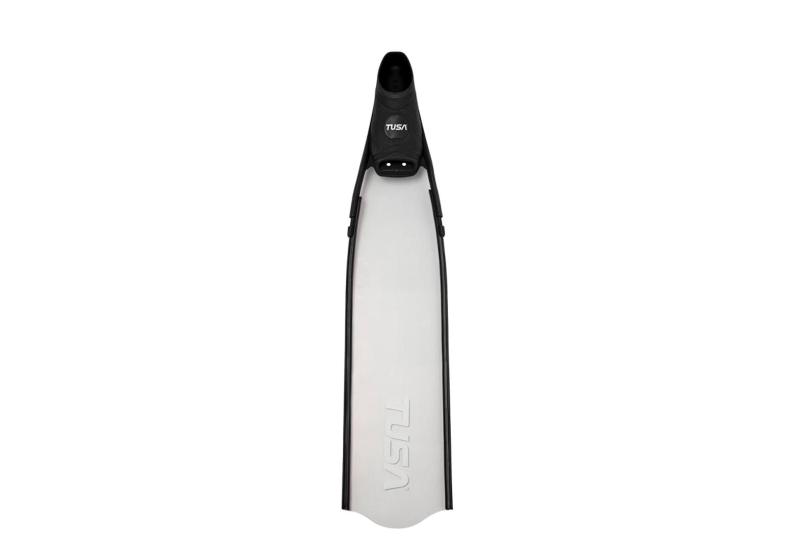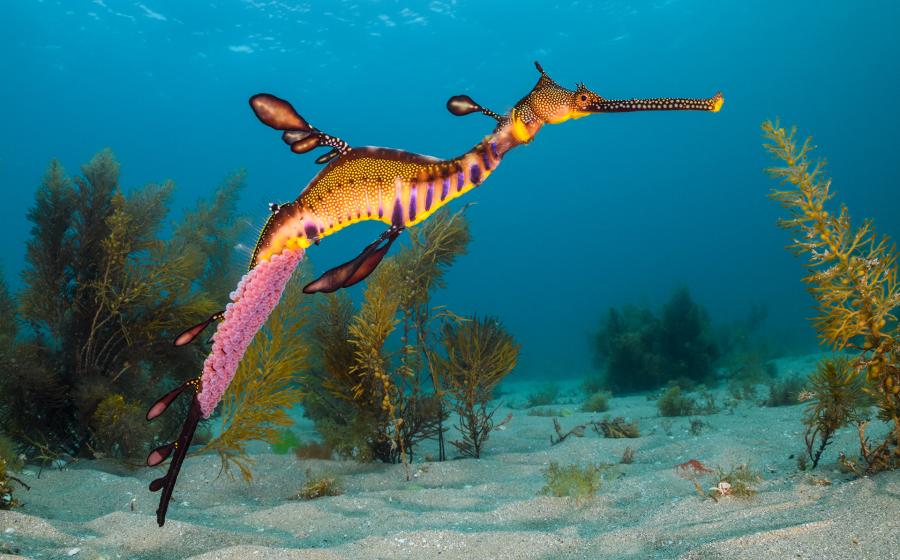Foot Rockets: Open-Heel Fins
 |
| After a morning of speed and maneuverability runs, the team boarded boats in the afternoon to test fins on Cozumel's world-famous reefs. |
July 2003
By John Brumm
Fins Reviewed in This Article
| Apollo Sports Black Bio-Fin Pro Atomic Aquatics SplitFin Atomic Aquatics Liquid Blue SplitFin Mares Volo TUSA X-Pert Zoom (SF-8) Aeris Velocity Aqua Lung Blades II Aqua Lung V-Tek Dacor Panther | Dacor Tiger (Blue) Genesis Scuba Aquaflex Genesis Scuba Blitz Mares Avanti Quattro Oceanic Vector Oceanic Vortex Scubapro Twin Jet Graphite Sherwood Scuba Trek Zeagle Teleoz |
On a Monday night in February, a group of divers nervously paces the lobby of the Brisas Resort in Cozumel. Their passports haven't been stolen, they aren't in trouble with the federales, and the airline hasn't lost their precious luggage. Instead, they are anxiously awaiting the arrival of 116 pairs of fins in nine enormous shipping containers, frozen in Cancun customs for more than two weeks, and promised to arrive the Saturday before. It is easy to see these divers aren't here for the fruity drinks and suntans--they are on a mission.
The "2003 Fin Test: It's a Tough Job But Somebody Has to Do It" T-shirts are the first hint. And then there are the underwater speedometers. And the stopwatches. And the scads of clipboards and No. 2 pencils. These divers aren't here to take it easy--they are here to test fins. The testers first met one another a year before, in Honduras's Bay Islands, forging friendships during testing for last year's fin review. Now, a year later, the group still has the easygoing rapport that comes only from shared experience.
Behind the Tests
They are a snapshot of our readership: two-thirds male, one-third female, of all ages and sizes, they have arrived from California and Rhode Island, North Dakota and Texas. The group includes a college professor, two computer consultants, a software developer, a marine biologist, a chemical engineer, a NASA diver, an energy policy analyst, a petro chemist, a senior account executive and two small business owners. With 125 years of diving experience and close to 7,000 dives under their collective weight belts, they share one important trait: a love of getting wet.
This year, their mission is to evaluate 30 of the slickest fins on the planet, both splits and paddles, adjustables and full-foots (we'll be looking at those next month). They know that when the fins arrive, their week will be no cakewalk--they'll be on the go from sunrise to sunset, and sometimes longer. And when the cargo of fins finally arrive at the resort, they breathe a collective sigh of relief that can be heard around the island.
Each morning, a squad of six divers grab underwater digital speedometers and hit the water for speed tests. Meanwhile, another squad armed with stopwatches heads for the slalom course set up beneath the Brisas pier to perform a series of timed maneuverability tests. And every afternoon, the test divers board Dive Paradise boats to kick their way along Cozumel's current-washed reefs. In the process, they learn a lot about fins, and they work their tails off. But if you were to ask them, they'll tell you that it was a vacation.
Putting Faces with the Fins
Meet a few members of our intrepid Cozumel fin test team:
||
|---|
|

|
| Chris Caka|
Chris CakaAge: 34.Occupation: NASA diver.Hometown: Kemah, Texas.Years diving: 14.Favorite adjustable fin: Apollo Sports Bio-Fin Pro.
Ever wonder who those divers are who help astronauts rehearse space walks in the giant pool at NASA's Neutral Buoyancy Laboratory? Say hello to Chris, an NBL training specialist and member of a 40-person civilian dive team whose dream job includes assisting astronauts with their underwater weightlessness training. With more than 900 hours logged with NASA, Chris dives just about every day for up to five hours, performing highly technical and physically demanding astronaut training exercises. He holds certifications as a dive supervisor, safety diver, underwater video diver, utility diver, environmental control systems specialist for the space suits, and is also a robotics, hydraulic and pneumatic crane operator. When he's not blowing bubbles with space cowboys, you'll find him at his local karaoke club, where he belts out classic Righteous Brothers tunes. And when he's not singing, he's, well, diving.
||
|---|
|

|
| Heather Carvey|
Heather CarveyAge: 25.Occupation: Small business owner.Hometown: Eureka, Mont.Years diving: 14.Favorite adjustable fin: Mares Volo.
Heather spent her formative years ice diving, night diving and spearfishing lakes and rivers just south of the Canadian border. As a teenager, she qualified for a marine study program and spent a couple months Down Under diving the Great Barrier Reef. After high school she attended Seattle's Divers Institute of Technology where she learned both underwater welding and diving physics. After a stint in the Gulf of Mexico working for several oil companies, she got hired on at NASA's Neutral Buoyancy Laboratory where she logged more than 700 hours as an underwater video operator and safety diver and met her dive buddy and boyfriend Chris Caka.
||
|---|
|

|
| Jeff Lovin|
Jeff LovinAge: 30.Occupation: IT support.Hometown: Costa Mesa, Calif.Years diving: 3.Favorite adjustable fin: Mares Volo.
Jeff Lovin has gone from trading guitar licks as the bass player of SoCal heavy metal band Seven 27 to chasing nurse sharks and eagle rays. Jeff's first taste of scuba was during an introductory dive on the Great Barrier Reef. That sealed the deal--he quickly got certified and convinced his bride-to-be to go on a honeymoon cruise to Cozumel and Roatan. During the week, Jeff is an application support specialist for a civil engineering firm, and on the weekends, he uses his assistant instructor certification as an excuse to get wet with dive classes at Laguna Beach or one of California's Channel Islands.
||
|---|
|

|
| Erin Rechisky|
Erin RechiskyAge: 30.Occupation: Marine biologist.Hometown: Narragansett, R.I.Years diving: 10.Favorite adjustable fin: Atomic Aquatics Liquid Blue SplitFin.
A typical workday for most people involves sitting behind a desk for eight-plus hours, bookended by agonizing rush-hour traffic. Not for Erin Rechisky. She spends her commute in a research skiff, and her office is the warm waters of the Bahamas. Erin works at the Caribbean Marine Research Center on idyllic Lee Stocking Island, Exumas, where she studies grouper and snapper populations by tagging them and tracking their movements using acoustic telemetry. She also assesses coral reefs to determine suitable sites for marine protected areas. So far this year, she's logged over 400 dives in the line of duty.
To learn more about these divers and meet the rest of our test team, check out our testers' profiles in "Meet the Fin Testers".
{mospagebreak} Testers' Choice Open-Heel Fins
||
|---|
|

|
| Apollo Sports Black Bio-Fin Pro|
1: Apollo Sports Black Bio-Fin Pro
One of two fins named "best overall" in our adjustable fin tests, the Bio-Fin Pro has the fastest speeds in both flutter and frog kicks. This fin may not have been the fastest on the slalom course, but it digs into turns and provides excellent control. It's one of only three fins to earn a "very good" rating for maneuverability. Made from 100 percent rubber, the Black Bio-Fin Pro is both comfortable and stable. Some test divers noted that its soft propeller blade is a bit too pliable. For divers who like a little more "feel" to their fins, Apollo's Metallic Blue fin is a little stiffer while providing very similar performance characteristics.
TESTER COMMENTS: "Felt like a part of my feet." --John Wheeler "Very easy in the turns. Good acceleration." --Heather Carvey "No muscle strain. Excellent control in tight places." --Jim Grier
||
|---|
|  |
|
| Atomic Aquatics SplitFin|
2: Atomic Aquatics SplitFin
A speed demon on the slalom course, Atomic's SplitFin is pretty fast flat-out, too. This robust fin's rather stiff, longer-than-average blade doesn't fold up in a power stroke like some other splits do--good for when that eagle ray flaps in out of nowhere and you want to accelerate. For close work, the fin is both nimble and efficient despite its length. A well-shaped foot pocket ensures stability and comfort. We found the SplitFin to offer the best buckle system of all the fins we tested, with a special buckle that slips over a mounting post on the fin. To detach, you simply squeeze both tabs and slip the buckle off the post. To attach, slide it onto the post where it clicks into place. Couldn't be easier.
TESTER COMMENTS: "My personal favorite!" --Scott Wertman "Great fin, fast fin, excellent quick-release buckles." --Erin Rechisky "Perfect blend of speed and maneuverability. A great dive fin." --J.D. Barnett "They swim fast in a current." --Vicki Durst
||
|---|
|

|
| Atomic Aquatics Liquid Blue SplitFin|
3: Atomic Aquatics Liquid Blue SplitFin
This new fin shares the spotlight with the Bio-Fin Pro as this year's best overall fins. Named the Liquid Blue because of its translucent look, this fin is identical in shape to the original Atomic SplitFin, but is made of a slightly softer high-performance thermoplastic rubber. This makes it a little lighter than the original and gives it a bit more snap. That said, the performance of the two fins is nearly identical. The Liquid Blue provides acceleration when it's time to go turbo, but is also very responsive. The Liquid Blue is just as stable as the original SplitFin, and shares the same excellent buckle system. One of three fins rated "very good" for maneuverability.
TESTER COMMENTS: "Real efficient fin. Feels light in the water." --Jeff Lovin "Comfortable. Easy to move around with in a wreck. An enjoyable fin." --John Wheeler "Good fin for frog kicking." --Heather Carvey
||
|---|
|

|
| Mares Volo|
4: Mares Volo
The popular Mares Volo has the distinction of being the top-performing paddle fin in this year's shootout. The fin uses what Mares calls an Optimum Pivoting Blade (OPB), a hinge-like design that allows the blade to angle itself into the ideal shape for forward thrust. This improves stability while decreasing muscle strain. Combine that with its light weight and comfortable foot pocket and you've got a fin that's barely a whisper on your feet. Quick out of the starting gate, the Volo tops out a little sooner than others on the straightaway, but is extremely agile when it comes to close-quarter work. Bottom line: It doesn't matter how you kick--flutter, frog or dolphin--the Volo is simply an easy fin to dive with.
TESTER COMMENTS: "An excellent fin." --Jeff Lovin "Don't even notice the fin on my feet." --Valorie Hodges "Comfortable and stable. An easy fin to dive with." --John Wheeler
||
|---|
|

|
| TUSA X-Pert Zoom (SF-8)|
5: TUSA X-Pert Zoom (SF-8)
This fin generates better-than-average speeds in the straightaway, some of the fastest times around the slalom course, and some of the best ergonomic scores. The X-Pert Zoom is easily recognizable by the sharp downward bend of its blade, which generates a forceful response to a relatively moderate kicking effort. It also enables you to maintain a stable, controllable attitude when you're hovering above coral. The fin is comfortable, although the foot pockets seem a bit short relative to their width. The X-Pert Zoom is also available in a special black compound with a slightly stiffer blade.
TESTER COMMENTS: "The advantage to this fin is its angle of thrust." --Donald Victorian "I just like this fin." --Heather Carvey "Not as stiff as my X-Pert Zoom Blacks. Good fin, though." --Chris Parsons
Other Fins Tested
Aeris Velocity
A flexible panel in the center of the blade contributes to stability and acceleration. While not the quickest on the slalom course, these fins provide good maneuverability, and are efficient when using the frog kick.
Aqua Lung Blades II
The Blades II offer good all-around ergonomic performance and are especially easy to put on, take off and adjust, thanks to a new buckle system that connects at the heel. They're a bit stiff, but above-average speeds were reached.
Aqua Lung V-Tek
They didn't tear our booties off coming out of the starting gate, but after a while, we could achieve some good speeds. The fins aren't as peppy on the slalom course. Shorter foot pockets.
Dacor Panther
They are slow on the straightaways, but these fins, which also use OPB technology, are even slower around the slalom course. A lot of leg and ankle stress produces very little propulsion. They are also stiff and difficult to maneuver.
Dacor Tiger (Blue)
Test divers either loved the Tiger Blues or hated them. Utilizing Optimized Pivoting Blade (OPB) technology, the fins generate only fair speeds and slalom course times, but good overall scores. Also available in a stiffer black version.
Genesis Scuba Aquaflex
The Aquaflex fins are among the fastest paddle fins on the straightaways, but among the slowest on the slalom course. The stiff blade isn't very responsive to small foot movements.
Genesis Scuba Blitz
These fins achieve respectable speeds in both flutter and frog kicks, but on the slalom course these fins are slow and difficult to control. They tend to be too much fin for female divers. Foot pockets are comfortable.
Mares Avanti Quattro
Explosive out of the gate, these fins smoke most other paddles in top speed. However, they're heavy for paddles and somewhat stiff. Considered a power fin, they're also both stable and highly maneuverable in close quarters.
Oceanic Vector
Versatile fins that are very efficient on the slalom course. They're also one of only three fins that earned a "very good" maneuverability rating. Fit is a problem among women, as the foot pockets are too short and too wide.
Oceanic Vortex
V-12 They're quick as a cat on the slalom course, but these heavy fins only kick up middle-of-the pack speeds while pumping straight ahead. While they are considered stable, comfortable fins by men, women commented that the extra-small is a little over-sized.
Scubapro Twin Jet Graphite
Short, wide fin blades provide very good stability. The fins are sluggish swimming straight ahead, but proficient in the turns, and they offer good maneuverability. Soft graphite material makes for a comfortable foot pocket. Also available in a stiffer black version.
Sherwood Scuba Trek
Pretty fast fin when the flutter kick is used, and is a real mover going frog. They're very spry on the slalom course, despite their size. Cavernous foot pockets created problems for some women. Also available in a stiffer black version.
FOR MORE INFORMATION
Aeris,www.diveaeris.com
** Apollo Sports,www.apollosportsusa.com
** Aqua Lung,www.aqualung.com
** Atomic Aquatics,www.atomicaquatics.com
** Dacor,www.divedacor.com
** Genesis Scuba,www.genesisscuba.com
** Mares,www.maresdacor.com
** Oceanic,www.oceanicworldwide.com
** Scubapro,www.scubapro.com
** Sherwood Scuba,www.sherwoodscuba.com
** Tusa,www.tusa.com
** Zeagle,**www.zeagle.com
A DIFFERENT KIND OF FIN
Zeagle Teleoz
The Teleoz was the orange among apples in our fin tests. Sandal-like straps atop a flat, board-like blade produced a fin that was slippery when we walked with them, unstable at depth and borderline useless in a strong current. This fin represents a completely different category of fin design--travel fins--and we plan to review them head-to-head in a future issue.
Home Base
||||
|---|---|---|
|

|
| Brisas Cozumel Resort|
Many thanks to Brisas Cozumel Resort for serving as headquarters; to Dive Paradise for tanks, boats and crucial logistics; and to Cetacea for use of underwater slates. {mospagebreak}
| Open-Heel Fin Objective Tests: Average Speeds |
|---|
| Flutter Kick| | Frog Kick |
| ---|---|--- |
| Mph| Fin| | Mph| Fin |
| ---|---|---|---|--- |
| 2.9| Apollo Sport Bio-Fin Pro| | 2.1| Apollo Sport Bio-Fin Pro |
| 2.7| Aqua Lung V-Tek| | 2.0| Aeris Velocity |
| | Atomic Aquatics Clear HP| | | Genesis Aquaflex |
| | Genesis Aquaflex| | | Mares Avanti Quatro |
| | Mares Avanti Quatro| | | Sherwood Trek |
| 2.6| Aqua Lung Blades II| | 1.9| Aqua Lung Blades II |
| | Atomic Aquatics Splitfin| | | Aqua Lung V-Tek |
| | Sherwood Trek| | | Atomic Aquatics Clear HP |
| | TUSA X-Pert Zoom| | | Genesis Blitz |
| 2.5| Genesis Blitz| | | Mares Volo |
| | Oceanic Vortex V-12| | | Oceanic Vortex V-12 |
| | Oceanic Vector| | | TUSA X-Pert Zoom |
| 2.4| Mares Volo| | 1.8| Atomic Aquatics Splitfin |
| 2.3| Aeris Velocity| | | Oceanic Vector |
| | Dacor Tiger| | 1.7| Dacor Panther |
| 2.2| Dacor Panther| | | Dacor Tiger |
| | Scubapro TwinJet Graphite| | | Scubapro Twinjet Graphite |
| | Zeagle Teleoz| | 1.6| Zeagle Teleoz |
| Six test divers, using both flutter kick and frog kick, at an average depth of 15 feet, took the following fins on three speed runs (for the flutter kick) and two speed runs (for the frog kick) using specially designed underwater digital speedometers. The highest speed for each fin was taken from each diver, then averaged, to come up with the following speeds. |
| NOTE: When applied to real world diving, the difference of 1/10th of a MPH is insignificant. Speed data should be used in conjunction with maneuverability and ergonomic results for a complete picture of a fin's performance. |
| Open-Heel Fin Objective Tests: Slalom Course |
|---|
| Time (in seconds)| Maneuverability*| Comments |
| ---|---|--- |
| 46| Atomic Aquatics Splitfin| Good| Near perfect blend of speed and maneuverability. |
| | Oceanic Vortex V-12| Good| Corners like a good blade. |
| 47| Oceanic Vector| Very Good| Great for carving the water. Extremely versatile. |
| | TUSA X-Pert Zoom| Good| Has a lot of pop. |
| 48| Atomic Aquatics Clear HP| Very Good| Long, but very efficient and maneuverable. |
| | Sherwood Trek| Good| Good maneuverability. |
| 49| Apollo Sports Bio-Fin Pro| Very Good| Easy in the turns. Like a part of your feet. |
| | Mares Volo| Good| An easy fin to dive with. |
| | Mares Avanti Quatro| Good| Easy to maneuver, good control. |
| | Scubapro Twinjet Graphite| Good| Decent fin, not great, not bad. |
| 50| Aqua Lung Blades II| Fair| Wobbles a bit, but small movements are easy. |
| 51| Aqua Lung V-Tek| Fair| Cumbersome in tight places. |
| 53| Aeris Velocity| Good| Very stable, but only average power. |
| | Dacor Tiger| Fair| Not as easy to maneuver as other fins. |
| 54| Genesis Aquaflex| Poor| Stiff and wobbly, due primarily to fit problems. |
| | Zeagle Teleoz| Poor| Dangerous. Like diving with no fins at all. |
| 55| Genesis Blitz| Fair| Big and cumbersome, difficult to maneuver. |
| 56| Dacor Panther| Poor| Stiff, wobbly, unresponsive, difficult to turn. |
| Six test divers, using a flutter kick, swam a figure-eight course in approximately 15 feet of water. While on the course divers' hands clutched weight belts or BC straps to ensure all maneuvering power was produced by the fins. Divers swam four circuits per fin using digital stopwatches. The fastest time for each fin was taken from each diver, then averaged, to come up with the following course times. |
| * Maneuverability is being defined as the ease of turning, as well as getting in and out of tight places using fin power; i.e. backing up, changing or reversing directions, using small fin movements. |
|| |---|
|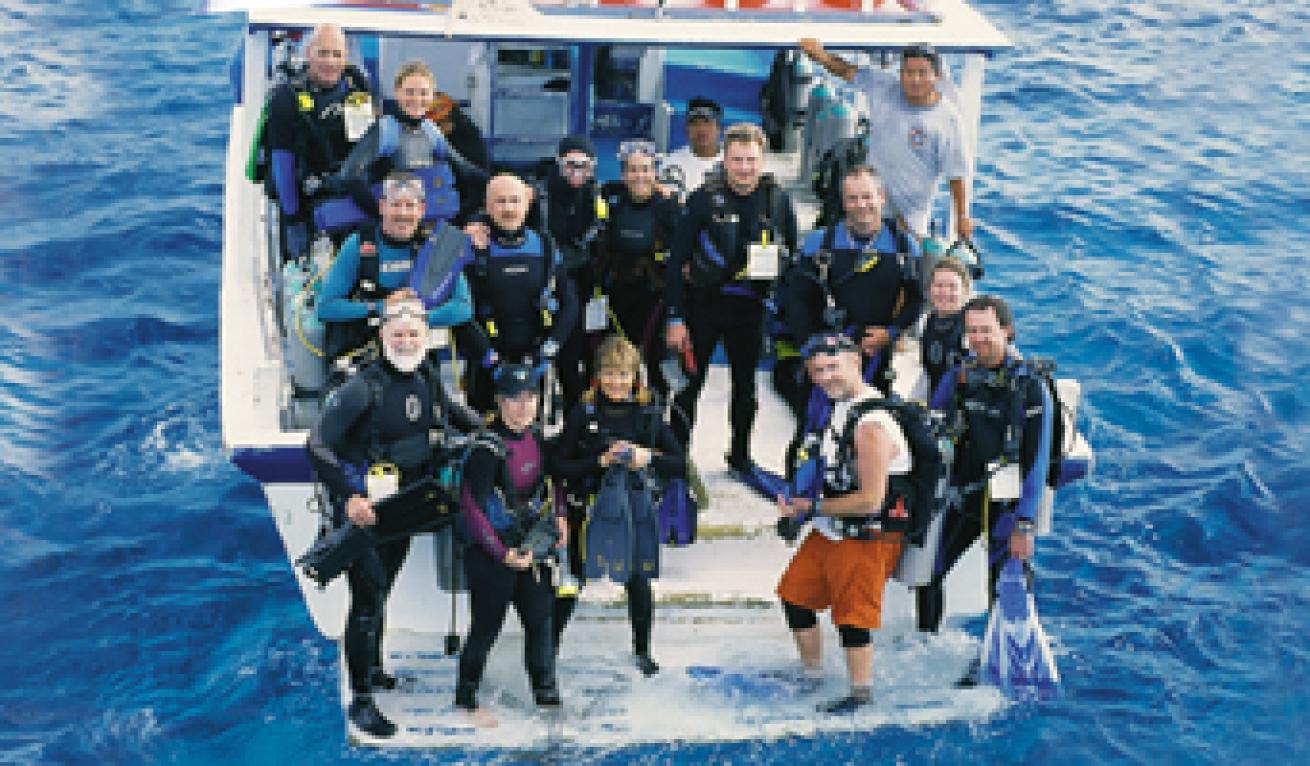
| | After a morning of speed and maneuverability runs, the team boarded boats in the afternoon to test fins on Cozumel's world-famous reefs.|
July 2003
By John Brumm
Fins Reviewed in This Article
||| |---|---|
| Apollo Sports Black Bio-Fin Pro Atomic Aquatics SplitFin Atomic Aquatics Liquid Blue SplitFin Mares Volo TUSA X-Pert Zoom (SF-8) Aeris Velocity Aqua Lung Blades II Aqua Lung V-Tek Dacor Panther | Dacor Tiger (Blue) Genesis Scuba Aquaflex Genesis Scuba Blitz Mares Avanti Quattro Oceanic Vector Oceanic Vortex Scubapro Twin Jet Graphite Sherwood Scuba Trek Zeagle Teleoz |On a Monday night in February, a group of divers nervously paces the lobby of the Brisas Resort in Cozumel. Their passports haven't been stolen, they aren't in trouble with the federales, and the airline hasn't lost their precious luggage. Instead, they are anxiously awaiting the arrival of 116 pairs of fins in nine enormous shipping containers, frozen in Cancun customs for more than two weeks, and promised to arrive the Saturday before. It is easy to see these divers aren't here for the fruity drinks and suntans--they are on a mission.
The "2003 Fin Test: It's a Tough Job But Somebody Has to Do It" T-shirts are the first hint. And then there are the underwater speedometers. And the stopwatches. And the scads of clipboards and No. 2 pencils. These divers aren't here to take it easy--they are here to test fins. The testers first met one another a year before, in Honduras's Bay Islands, forging friendships during testing for last year's fin review. Now, a year later, the group still has the easygoing rapport that comes only from shared experience.
Behind the Tests
They are a snapshot of our readership: two-thirds male, one-third female, of all ages and sizes, they have arrived from California and Rhode Island, North Dakota and Texas. The group includes a college professor, two computer consultants, a software developer, a marine biologist, a chemical engineer, a NASA diver, an energy policy analyst, a petro chemist, a senior account executive and two small business owners. With 125 years of diving experience and close to 7,000 dives under their collective weight belts, they share one important trait: a love of getting wet.
This year, their mission is to evaluate 30 of the slickest fins on the planet, both splits and paddles, adjustables and full-foots (we'll be looking at those next month). They know that when the fins arrive, their week will be no cakewalk--they'll be on the go from sunrise to sunset, and sometimes longer. And when the cargo of fins finally arrive at the resort, they breathe a collective sigh of relief that can be heard around the island.
Each morning, a squad of six divers grab underwater digital speedometers and hit the water for speed tests. Meanwhile, another squad armed with stopwatches heads for the slalom course set up beneath the Brisas pier to perform a series of timed maneuverability tests. And every afternoon, the test divers board Dive Paradise boats to kick their way along Cozumel's current-washed reefs. In the process, they learn a lot about fins, and they work their tails off. But if you were to ask them, they'll tell you that it was a vacation.
Putting Faces with the Fins
Meet a few members of our intrepid Cozumel fin test team:
|| |---|
|
| | Chris Caka|
Age: 34.
Occupation: NASA diver.
Hometown: Kemah, Texas.
Years diving: 14.
Favorite adjustable fin: Apollo Sports Bio-Fin Pro.
Ever wonder who those divers are who help astronauts rehearse space walks in the giant pool at NASA's Neutral Buoyancy Laboratory? Say hello to Chris, an NBL training specialist and member of a 40-person civilian dive team whose dream job includes assisting astronauts with their underwater weightlessness training. With more than 900 hours logged with NASA, Chris dives just about every day for up to five hours, performing highly technical and physically demanding astronaut training exercises. He holds certifications as a dive supervisor, safety diver, underwater video diver, utility diver, environmental control systems specialist for the space suits, and is also a robotics, hydraulic and pneumatic crane operator. When he's not blowing bubbles with space cowboys, you'll find him at his local karaoke club, where he belts out classic Righteous Brothers tunes. And when he's not singing, he's, well, diving.
|| |---|
|
| | Heather Carvey|
Age: 25.
Occupation: Small business owner.
Hometown: Eureka, Mont.
Years diving: 14.
Favorite adjustable fin: Mares Volo.
Heather spent her formative years ice diving, night diving and spearfishing lakes and rivers just south of the Canadian border. As a teenager, she qualified for a marine study program and spent a couple months Down Under diving the Great Barrier Reef. After high school she attended Seattle's Divers Institute of Technology where she learned both underwater welding and diving physics. After a stint in the Gulf of Mexico working for several oil companies, she got hired on at NASA's Neutral Buoyancy Laboratory where she logged more than 700 hours as an underwater video operator and safety diver and met her dive buddy and boyfriend Chris Caka.
|| |---|
|
| | Jeff Lovin|
Age: 30.
Occupation: IT support.
Hometown: Costa Mesa, Calif.
Years diving: 3.
Favorite adjustable fin: Mares Volo.
Jeff Lovin has gone from trading guitar licks as the bass player of SoCal heavy metal band Seven 27 to chasing nurse sharks and eagle rays. Jeff's first taste of scuba was during an introductory dive on the Great Barrier Reef. That sealed the deal--he quickly got certified and convinced his bride-to-be to go on a honeymoon cruise to Cozumel and Roatan. During the week, Jeff is an application support specialist for a civil engineering firm, and on the weekends, he uses his assistant instructor certification as an excuse to get wet with dive classes at Laguna Beach or one of California's Channel Islands.
|| |---|
|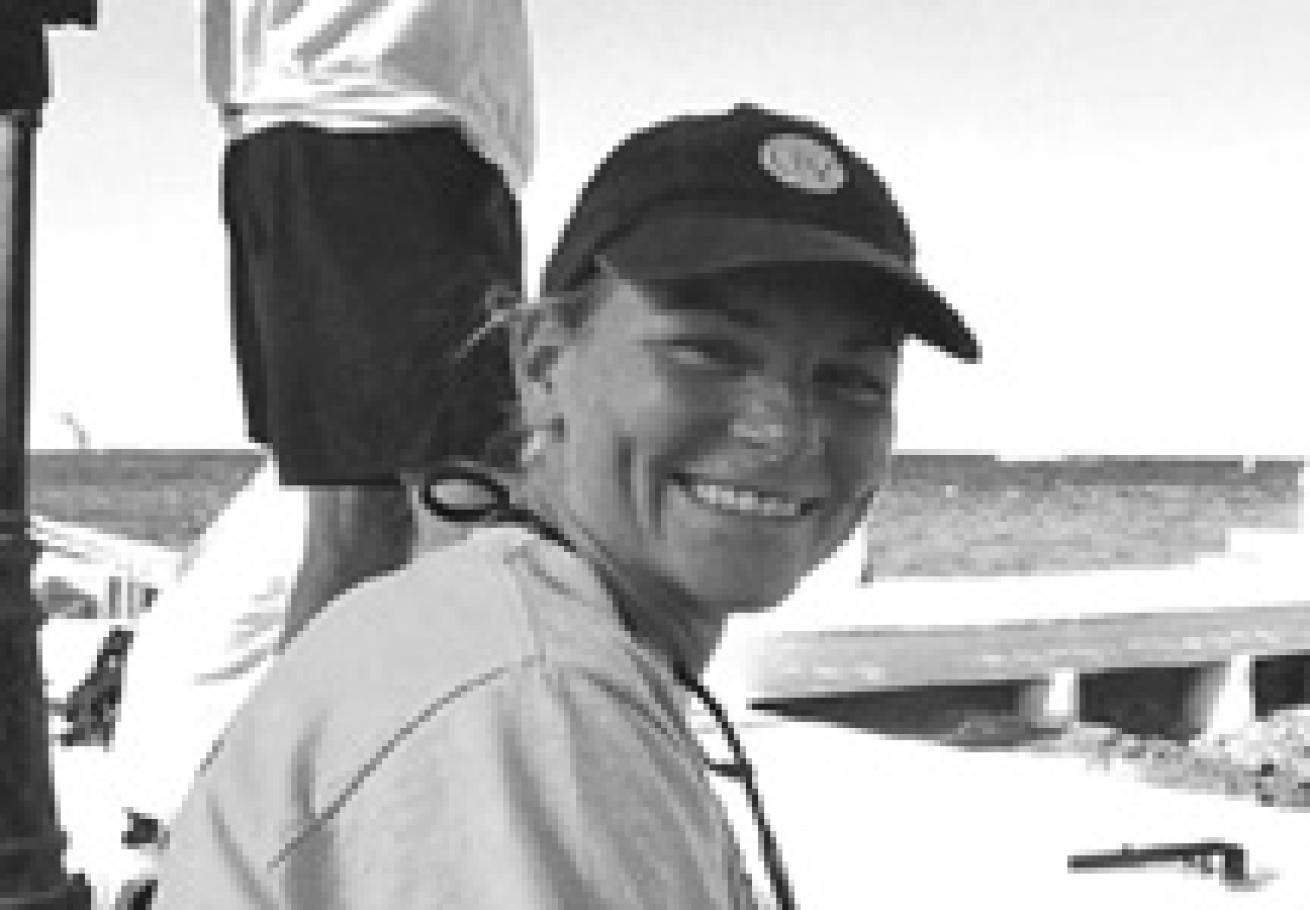
| | Erin Rechisky|
Age: 30.
Occupation: Marine biologist.
Hometown: Narragansett, R.I.
Years diving: 10.
Favorite adjustable fin: Atomic Aquatics Liquid Blue SplitFin.
A typical workday for most people involves sitting behind a desk for eight-plus hours, bookended by agonizing rush-hour traffic. Not for Erin Rechisky. She spends her commute in a research skiff, and her office is the warm waters of the Bahamas. Erin works at the Caribbean Marine Research Center on idyllic Lee Stocking Island, Exumas, where she studies grouper and snapper populations by tagging them and tracking their movements using acoustic telemetry. She also assesses coral reefs to determine suitable sites for marine protected areas. So far this year, she's logged over 400 dives in the line of duty.
To learn more about these divers and meet the rest of our test team, check out our testers' profiles in "Meet the Fin Testers".
{mospagebreak} Testers' Choice Open-Heel Fins
|| |---|
|
| | Apollo Sports Black Bio-Fin Pro|
One of two fins named "best overall" in our adjustable fin tests, the Bio-Fin Pro has the fastest speeds in both flutter and frog kicks. This fin may not have been the fastest on the slalom course, but it digs into turns and provides excellent control. It's one of only three fins to earn a "very good" rating for maneuverability. Made from 100 percent rubber, the Black Bio-Fin Pro is both comfortable and stable. Some test divers noted that its soft propeller blade is a bit too pliable. For divers who like a little more "feel" to their fins, Apollo's Metallic Blue fin is a little stiffer while providing very similar performance characteristics.
TESTER COMMENTS: "Felt like a part of my feet." --John Wheeler "Very easy in the turns. Good acceleration." --Heather Carvey "No muscle strain. Excellent control in tight places." --Jim Grier
|| |---|
| |
| Atomic Aquatics SplitFin|
2: Atomic Aquatics SplitFin
|
| Atomic Aquatics SplitFin|
2: Atomic Aquatics SplitFinA speed demon on the slalom course, Atomic's SplitFin is pretty fast flat-out, too. This robust fin's rather stiff, longer-than-average blade doesn't fold up in a power stroke like some other splits do--good for when that eagle ray flaps in out of nowhere and you want to accelerate. For close work, the fin is both nimble and efficient despite its length. A well-shaped foot pocket ensures stability and comfort. We found the SplitFin to offer the best buckle system of all the fins we tested, with a special buckle that slips over a mounting post on the fin. To detach, you simply squeeze both tabs and slip the buckle off the post. To attach, slide it onto the post where it clicks into place. Couldn't be easier.
TESTER COMMENTS: "My personal favorite!" --Scott Wertman "Great fin, fast fin, excellent quick-release buckles." --Erin Rechisky "Perfect blend of speed and maneuverability. A great dive fin." --J.D. Barnett "They swim fast in a current." --Vicki Durst
|| |---|
|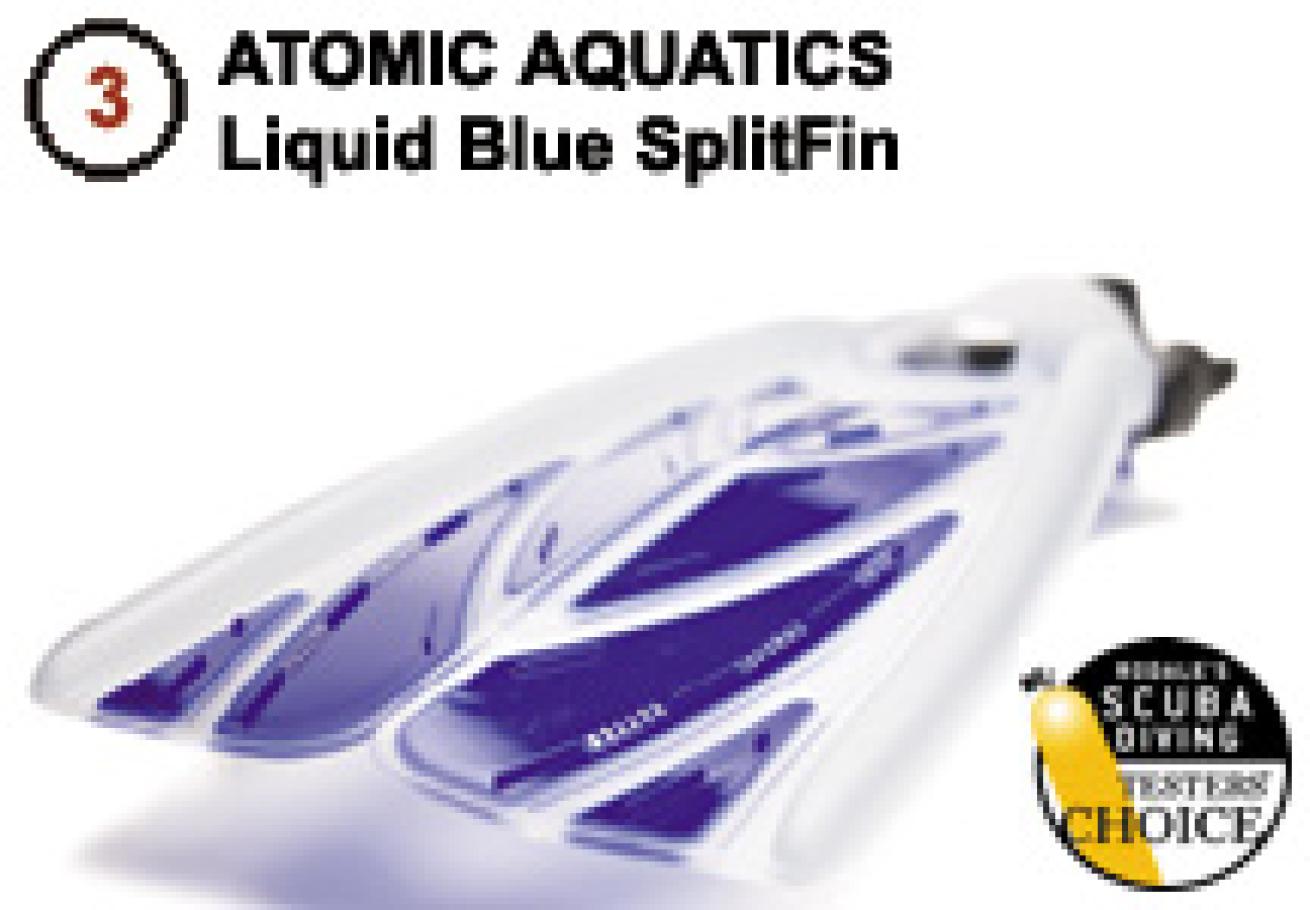
| | Atomic Aquatics Liquid Blue SplitFin|
This new fin shares the spotlight with the Bio-Fin Pro as this year's best overall fins. Named the Liquid Blue because of its translucent look, this fin is identical in shape to the original Atomic SplitFin, but is made of a slightly softer high-performance thermoplastic rubber. This makes it a little lighter than the original and gives it a bit more snap. That said, the performance of the two fins is nearly identical. The Liquid Blue provides acceleration when it's time to go turbo, but is also very responsive. The Liquid Blue is just as stable as the original SplitFin, and shares the same excellent buckle system. One of three fins rated "very good" for maneuverability.
TESTER COMMENTS: "Real efficient fin. Feels light in the water." --Jeff Lovin "Comfortable. Easy to move around with in a wreck. An enjoyable fin." --John Wheeler "Good fin for frog kicking." --Heather Carvey
|| |---|
|
| | Mares Volo|
The popular Mares Volo has the distinction of being the top-performing paddle fin in this year's shootout. The fin uses what Mares calls an Optimum Pivoting Blade (OPB), a hinge-like design that allows the blade to angle itself into the ideal shape for forward thrust. This improves stability while decreasing muscle strain. Combine that with its light weight and comfortable foot pocket and you've got a fin that's barely a whisper on your feet. Quick out of the starting gate, the Volo tops out a little sooner than others on the straightaway, but is extremely agile when it comes to close-quarter work. Bottom line: It doesn't matter how you kick--flutter, frog or dolphin--the Volo is simply an easy fin to dive with.
TESTER COMMENTS: "An excellent fin." --Jeff Lovin "Don't even notice the fin on my feet." --Valorie Hodges "Comfortable and stable. An easy fin to dive with." --John Wheeler
|| |---|
|
| | TUSA X-Pert Zoom (SF-8)|
This fin generates better-than-average speeds in the straightaway, some of the fastest times around the slalom course, and some of the best ergonomic scores. The X-Pert Zoom is easily recognizable by the sharp downward bend of its blade, which generates a forceful response to a relatively moderate kicking effort. It also enables you to maintain a stable, controllable attitude when you're hovering above coral. The fin is comfortable, although the foot pockets seem a bit short relative to their width. The X-Pert Zoom is also available in a special black compound with a slightly stiffer blade.
TESTER COMMENTS: "The advantage to this fin is its angle of thrust." --Donald Victorian "I just like this fin." --Heather Carvey "Not as stiff as my X-Pert Zoom Blacks. Good fin, though." --Chris Parsons
Other Fins Tested
Aeris Velocity
A flexible panel in the center of the blade contributes to stability and acceleration. While not the quickest on the slalom course, these fins provide good maneuverability, and are efficient when using the frog kick.
Aqua Lung Blades II
The Blades II offer good all-around ergonomic performance and are especially easy to put on, take off and adjust, thanks to a new buckle system that connects at the heel. They're a bit stiff, but above-average speeds were reached.
Aqua Lung V-Tek
They didn't tear our booties off coming out of the starting gate, but after a while, we could achieve some good speeds. The fins aren't as peppy on the slalom course. Shorter foot pockets.
Dacor Panther
They are slow on the straightaways, but these fins, which also use OPB technology, are even slower around the slalom course. A lot of leg and ankle stress produces very little propulsion. They are also stiff and difficult to maneuver.
Dacor Tiger (Blue)
Test divers either loved the Tiger Blues or hated them. Utilizing Optimized Pivoting Blade (OPB) technology, the fins generate only fair speeds and slalom course times, but good overall scores. Also available in a stiffer black version.
Genesis Scuba Aquaflex
The Aquaflex fins are among the fastest paddle fins on the straightaways, but among the slowest on the slalom course. The stiff blade isn't very responsive to small foot movements.
Genesis Scuba Blitz
These fins achieve respectable speeds in both flutter and frog kicks, but on the slalom course these fins are slow and difficult to control. They tend to be too much fin for female divers. Foot pockets are comfortable.
Mares Avanti Quattro
Explosive out of the gate, these fins smoke most other paddles in top speed. However, they're heavy for paddles and somewhat stiff. Considered a power fin, they're also both stable and highly maneuverable in close quarters.
Oceanic Vector
Versatile fins that are very efficient on the slalom course. They're also one of only three fins that earned a "very good" maneuverability rating. Fit is a problem among women, as the foot pockets are too short and too wide.
Oceanic Vortex
V-12 They're quick as a cat on the slalom course, but these heavy fins only kick up middle-of-the pack speeds while pumping straight ahead. While they are considered stable, comfortable fins by men, women commented that the extra-small is a little over-sized.
Scubapro Twin Jet Graphite
Short, wide fin blades provide very good stability. The fins are sluggish swimming straight ahead, but proficient in the turns, and they offer good maneuverability. Soft graphite material makes for a comfortable foot pocket. Also available in a stiffer black version.
Sherwood Scuba Trek
Pretty fast fin when the flutter kick is used, and is a real mover going frog. They're very spry on the slalom course, despite their size. Cavernous foot pockets created problems for some women. Also available in a stiffer black version.
FOR MORE INFORMATION
Aeris,www.diveaeris.com
** Apollo Sports,www.apollosportsusa.com
** Aqua Lung,www.aqualung.com
** Atomic Aquatics,www.atomicaquatics.com
** Dacor,www.divedacor.com
** Genesis Scuba,www.genesisscuba.com
** Mares,www.maresdacor.com
** Oceanic,www.oceanicworldwide.com
** Scubapro,www.scubapro.com
** Sherwood Scuba,www.sherwoodscuba.com
** Tusa,www.tusa.com
** Zeagle,**www.zeagle.com
A DIFFERENT KIND OF FIN
Zeagle Teleoz
The Teleoz was the orange among apples in our fin tests. Sandal-like straps atop a flat, board-like blade produced a fin that was slippery when we walked with them, unstable at depth and borderline useless in a strong current. This fin represents a completely different category of fin design--travel fins--and we plan to review them head-to-head in a future issue.
Home Base
|||| |---|---|---|
|<
table>

| | Brisas Cozumel Resort|
|Open-Heel Fin Objective Tests: Average Speeds| |---| |Flutter Kick| | Frog Kick| |---|---|---| |Mph| Fin| | Mph| Fin| |---|---|---|---|---|
| 2.9| Apollo Sport Bio-Fin Pro| | 2.1| Apollo Sport Bio-Fin Pro| | 2.7| Aqua Lung V-Tek| | 2.0| Aeris Velocity| | | Atomic Aquatics Clear HP| | | Genesis Aquaflex| | | Genesis Aquaflex| | | Mares Avanti Quatro| | | Mares Avanti Quatro| | | Sherwood Trek| | 2.6| Aqua Lung Blades II| | 1.9| Aqua Lung Blades II| | | Atomic Aquatics Splitfin| | | Aqua Lung V-Tek| | | Sherwood Trek| | | Atomic Aquatics Clear HP| | | TUSA X-Pert Zoom| | | Genesis Blitz| | 2.5| Genesis Blitz| | | Mares Volo| | | Oceanic Vortex V-12| | | Oceanic Vortex V-12| | | Oceanic Vector| | | TUSA X-Pert Zoom| | 2.4| Mares Volo| | 1.8| Atomic Aquatics Splitfin| | 2.3| Aeris Velocity| | | Oceanic Vector| | | Dacor Tiger| | 1.7| Dacor Panther| | 2.2| Dacor Panther| | | Dacor Tiger| | | Scubapro TwinJet Graphite| | | Scubapro Twinjet Graphite| | | Zeagle Teleoz| | 1.6| Zeagle Teleoz| | Six test divers, using both flutter kick and frog kick, at an average depth of 15 feet, took the following fins on three speed runs (for the flutter kick) and two speed runs (for the frog kick) using specially designed underwater digital speedometers. The highest speed for each fin was taken from each diver, then averaged, to come up with the following speeds.| | NOTE: When applied to real world diving, the difference of 1/10th of a MPH is insignificant. Speed data should be used in conjunction with maneuverability and ergonomic results for a complete picture of a fin's performance.||Open-Heel Fin Objective Tests: Slalom Course| |---| |Time (in seconds)| Maneuverability*| Comments| |---|---|---|
| 46| Atomic Aquatics Splitfin| Good| Near perfect blend of speed and maneuverability.| | | Oceanic Vortex V-12| Good| Corners like a good blade.| | 47| Oceanic Vector| Very Good| Great for carving the water. Extremely versatile.| | | TUSA X-Pert Zoom| Good| Has a lot of pop.| | 48| Atomic Aquatics Clear HP| Very Good| Long, but very efficient and maneuverable.| | | Sherwood Trek| Good| Good maneuverability.| | 49| Apollo Sports Bio-Fin Pro| Very Good| Easy in the turns. Like a part of your feet.| | | Mares Volo| Good| An easy fin to dive with.| | | Mares Avanti Quatro| Good| Easy to maneuver, good control.| | | Scubapro Twinjet Graphite| Good| Decent fin, not great, not bad.| | 50| Aqua Lung Blades II| Fair| Wobbles a bit, but small movements are easy.| | 51| Aqua Lung V-Tek| Fair| Cumbersome in tight places.| | 53| Aeris Velocity| Good| Very stable, but only average power.| | | Dacor Tiger| Fair| Not as easy to maneuver as other fins.| | 54| Genesis Aquaflex| Poor| Stiff and wobbly, due primarily to fit problems.| | | Zeagle Teleoz| Poor| Dangerous. Like diving with no fins at all.| | 55| Genesis Blitz| Fair| Big and cumbersome, difficult to maneuver.| | 56| Dacor Panther| Poor| Stiff, wobbly, unresponsive, difficult to turn.| | Six test divers, using a flutter kick, swam a figure-eight course in approximately 15 feet of water. While on the course divers' hands clutched weight belts or BC straps to ensure all maneuvering power was produced by the fins. Divers swam four circuits per fin using digital stopwatches. The fastest time for each fin was taken from each diver, then averaged, to come up with the following course times.| | * Maneuverability is being defined as the ease of turning, as well as getting in and out of tight places using fin power; i.e. backing up, changing or reversing directions, using small fin movements.|
